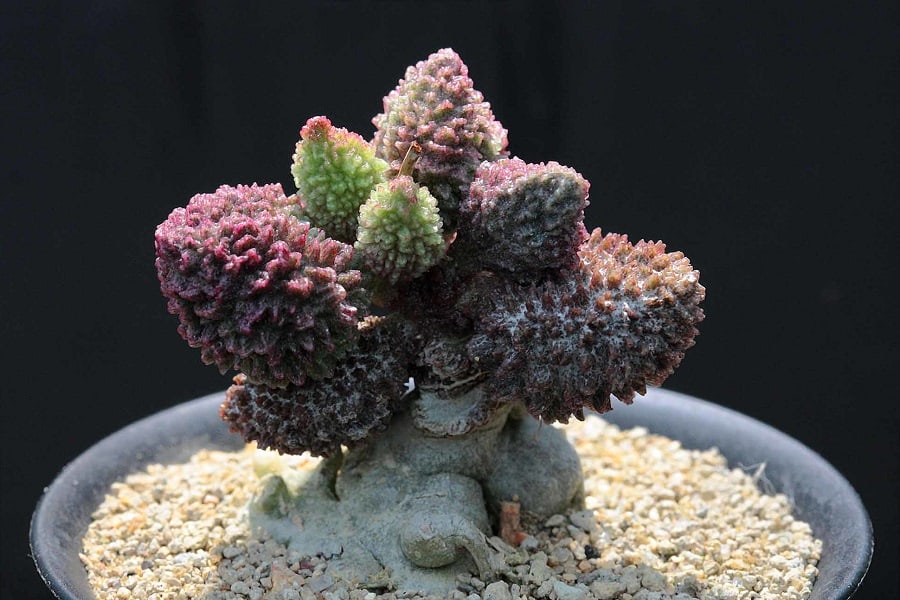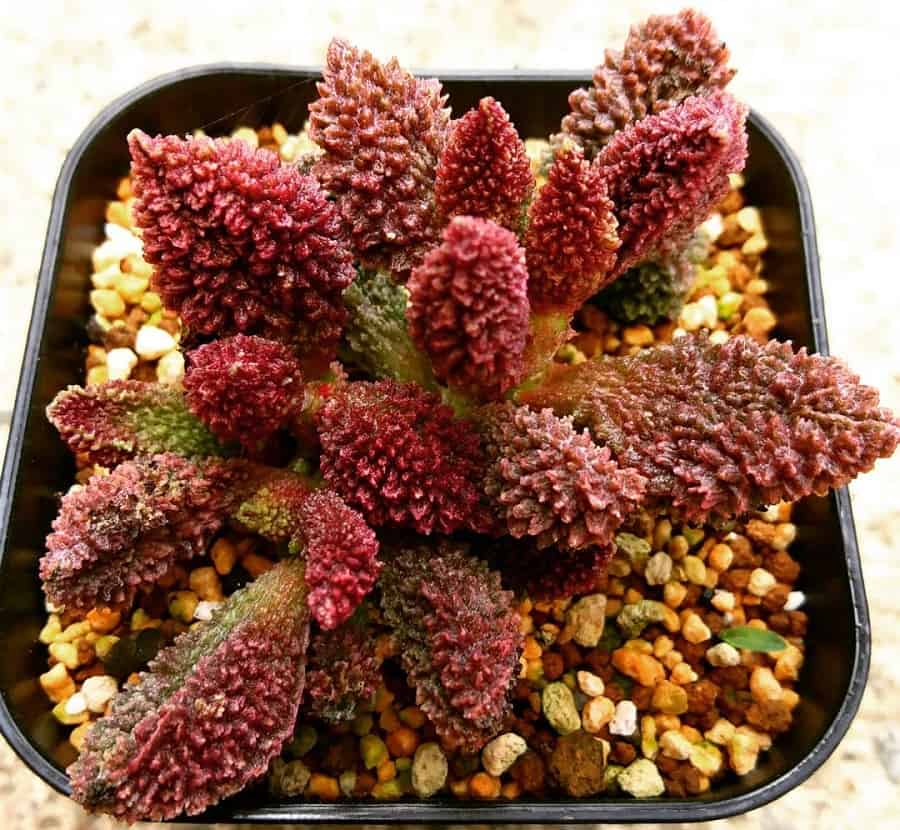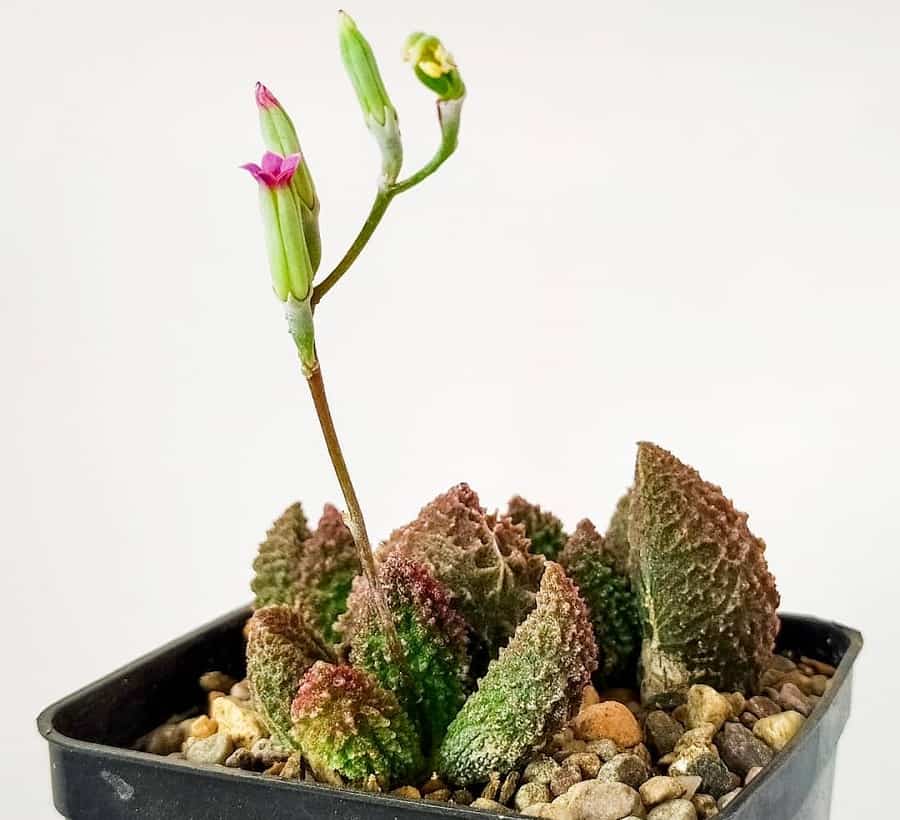You’re Growing It Wrong! Adromischus herrei Tips
Are you struggling to keep your Adromischus herrei alive and thriving? Don’t worry, you’re not alone! This quirky little succulent from South Africa can be tricky to care for if you don’t know its secrets. But stick with us, and you’ll soon have a flourishing Adromischus herrei that will be the envy of all your plant-lover friends. Get ready to uncover the insider tips and tricks that will transform your care routine!

Contents
About Adromischus herrei
Before we dive into the care specifics, let’s talk about what makes Adromischus herrei so special. This petite plant has thin, branching stems adorned with thick, textured leaves in mesmerizing shades of gray, red, green, brown, and purple. As the leaves mature, they develop a waxy coating and ridged surfaces, adding to their exotic appeal. During the blooming season, small green and pink flowers emerge. In its native South African habitat, Adromischus herrei wedges itself between granite crevices, hinting at its hardy yet particular nature.
Related Post:
30 Exquisite Adromischus Species [With Pictures]
How To Care For Adromischus herrei
Light Requirements
Adromischus herrei craves lots of bright light, around 6-8 hours of direct sun per day. However, be careful with intense midday rays, which can scorch its delicate leaves, especially during summer’s peak. Aim to give it plenty of morning sunshine while providing some high-filtered shade during the hottest afternoon hours.
If growing indoors, place your Adromischus herrei in a south or west-facing window for maximum light exposure. Can’t find the perfect sunny spot? Invest in a quality grow light and keep it just 4-6 inches above the plant for 12-14 hours per day.
Water Needs
This succulent likes a deep but infrequent drink. Wait until the soil is completely dry before watering again, which may be every 7-10 days in summer and just once a month during the winter dormancy period. When you do water, use a good soak until excess moisture drains from the bottom of the pot.
The biggest killer of Adromischus herrei is overwatering, which leads to dreaded root rot. Always err on the side of underwatering rather than overwatering this drought-tolerant plant.
Soil Mixture

Succulent soil is a must for happy roots. A well-draining potting mix designed for cacti and succulents is ideal. You can also make your own by combining:
- 2 parts potting soil
- 2 parts coarse sand or perlite
- 1 part crushed granite or pebbles
The key is creating a chunky, extremely porous soil that won’t stay soggy. Excess moisture should drain away rapidly.
Temperature & Humidity
Adromischus herrei prefers average warmth, between 65-80°F during spring through fall’s active growth period. Reduce watering and provide slightly cooler temps around 50-65°F over winter.
As for humidity, this plant does best with average to low levels, making it well-suited for home environments.
Fertilizer
Feed your Adromischus herrei every 4-6 weeks during the spring and summer growing season with a balanced succulent fertilizer. Look for one high in potassium and low in nitrogen to prevent excessive growth. You can either use a concentrated liquid fertilizer diluted to half strength or apply a slow-release granular fertilizer according to label instructions.
Avoid fertilizing in the winter when the plant is dormant and resting.
Pests and Diseases
While generally a low-maintenance plant, Adromischus herrei can occasionally face some pesky issues. Keep an eye out for cottony white mealybugs trying to set up camp in those cute leaf crevices. If spotted, dab them with an alcohol-dipped cotton swab or hit them with a insecticidal soap spray.
The biggest threat is potentially deadly root rot from overwatering. If you notice mushy, discolored stems and leaves that pull off easily, it’s a sure sign you’ve got a rotting situation. The fix? Snip off any unsightly parts and replant the remaining healthy pieces in fresh, bone-dry soil.
Other more minor annoyances could include sunburn patches, funky growths from moisture inconsistencies, or fungal friends like powdery mildew trying to arrive uninvited. But with proper watering and environmental conditions, your Adromischus should stay happy and problem-free!
Adromischus herrei Propagation Tips
One of the best parts about growing Adromischus herrei is how easy it is to multiply your collection for free! This delightful succulent readily propagates from individual leaves or stem cuttings. Before you know it, you’ll have an army of new plants to share with friends or add to your indoor jungle.

Leaf Propagation
- Gently twist off a firm, healthy leaf from the main plant, ensuring the entire leaf detaches cleanly.
- Allow the leaf to callus over for 2-3 days by leaving it out to dry.
- Fill a shallow tray or pot with well-draining cactus/succulent soil.
- Place the calloused leaf on top of the soil horizontally and press down gently so the base is touching the soil.
- Lightly mist the soil whenever it begins to fully dry out.
- Within 4-8 weeks, you should see tiny new rosettes sprouting from the leaf’s base!
- Once the propagated rosettes have their own roots, you can pick them up and transplant individually.
Stem Cutting Propagation
- Using a clean, sharp scissors or knife, snip off a 2-4 inch stem cutting from a mature plant.
- Allow the cut end to callus over for 3-5 days before propagating.
- Once calloused, stick the stem vertically into a new pot with fresh succulent soil, burying 1⁄3 of its length.
- Lightly mist the soil when needed to keep it very lightly moist.
- In 4-8 weeks, new offset rosettes should emerge from the stem.
- Once rooted, you can optionally cut the offsets to separate them into individual plants.
Be patient, as Adromischus herrei propagations can take their sweet time developing a full root system. But stick with it, and you’ll soon have a brand new crop of these adorable geometrically-patterned plants!
